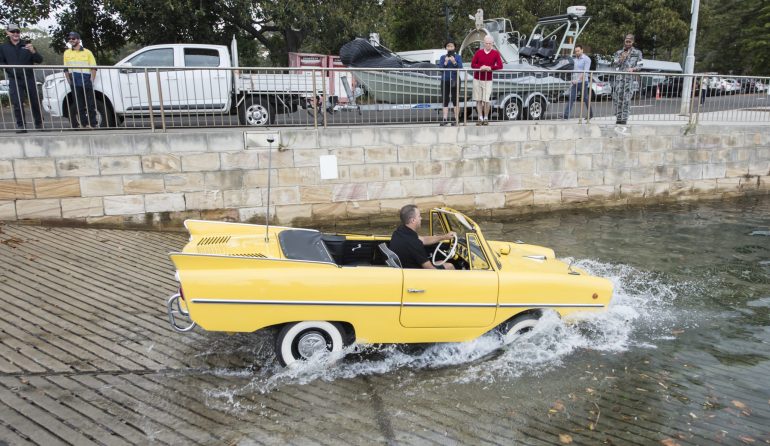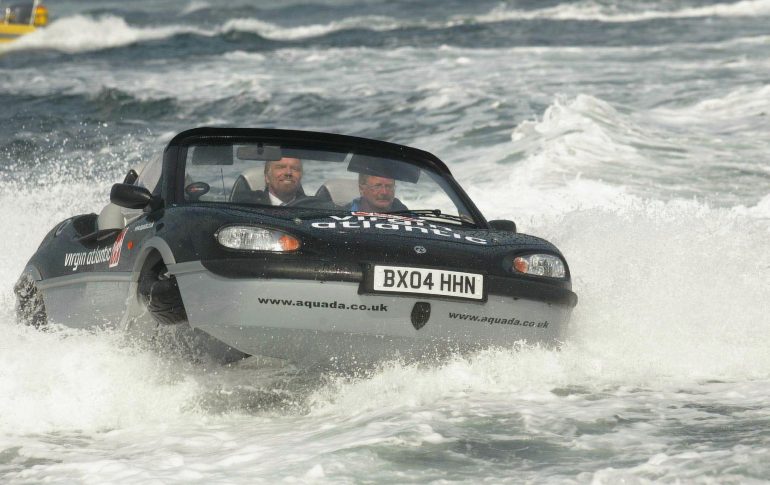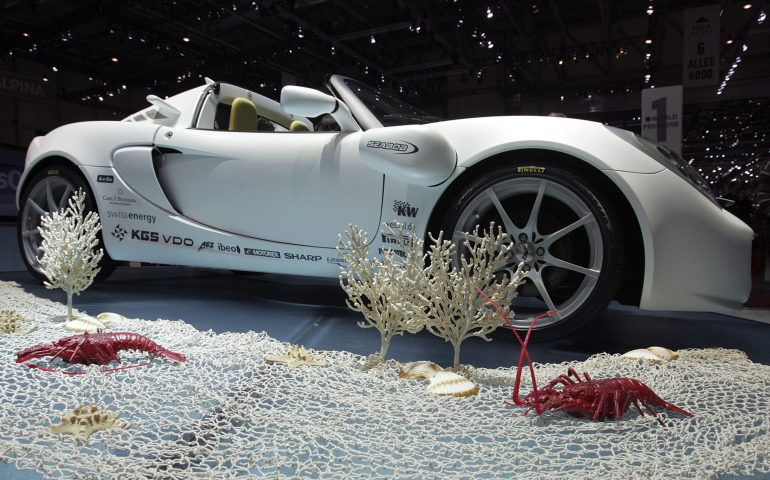For over two centuries, amphibious vehicles have attempted to defy traditional boundaries of mobility by daring to navigate both the solid land and the restless sea. They’re testament to the ceaseless and ambitious quest to expand the realm of the possible. However, as with many feats of engineering, practical execution often proves more challenging than its theoretical premise.
This discrepancy doesn’t undermine the awe-inspiring nature of amphibious vehicles, but rather emphasises the staggeringly complex engineering challenges involved in their creation.
Despite the hurdles, the promise of a mass-market amphibious car endures, fuelled by technological advancements and the idea that movement is not limited by the elements.
This journey through the history, realities, and potential future of these vehicles – as well as a list of the most famous amphibious vehicles ever made – including the Amphicar – will illustrate not just their versatility, but also their testament to audacity and innovation.
So ‘water’ we waiting for. Let’s go!
The History of Amphibious Vehicles
The story of the amphibious car dates back longer than you might think. Italian inventor Prince Raimondo di Sangro and English mechanical engineer Sir Samuel Bentham made human-powered amphibious carriages in the late eighteenth century. However, the first of the self-propelled amphibious vehicles – and said by some to be America’s first ever automobile – was the fifteen-tonne Orukter Amphibolos built in 1805 by American inventor Oliver Evans. He’s believed to have said ‘I have no doubt but that my engines will propel boats against the current of the Mississippi, and wagons on turnpike roads with great profit.’
While the Orukter Amphibolos is often recognised as the first self-propelled amphibious vehicle, there’s no definitive proof it ever successfully operated in the water.
Gail Borden, the man who invented sweetened condensed milk, attempted a sail-powered amphibious car in 1849. Over the next seventy years or so, amphibious vehicles were little more than attempting more and more creative ways of attaching wheels and an axle to the hull of a boat.
The first functional amphibious vehicles emerged during World War I, predominantly for military purposes, offering tactical advantages of land and water mobility. They played a crucial role in World War II, with the American DUKW, or ‘Duck’ being a standout example – and one of the most famous amphibious vehicles – due to its significant role in the D-Day landings.
Post-war, the focus shifted towards civilian use, with the 1960s Amphicar introducing the public to the novelty of transitioning from road to water. Despite limited production, the Amphicar, a symbol of adventure and innovation, remains a cult classic.
Let’s take a look at some of the coolest amphibious vehicles ever made.
DUKW (aka Duck)
Production: 1942 – 1945 | Engine: 4.0 litre straight-six | Weight: 6.2 tonnes
The six-wheeled modification of the US Army’s GMC ‘Jimmy’ truck was used during World War II on the D-Day beaches of Normandy. The name comes from General Motors’ system of vehicle nomenclature during World War II –
D – 1942 production model
U – utility vehicle
K – all-wheel drive
W – tandem rear axles
The Duck had a maximum speed of 50 mph on land and six knots (6.4 mph) on water and in its short production lifespan, over 21,000 were built.
Amphicar

1966 Amphicar 770 (Credit: James D. Morgan / Contributor via Getty Images)
Production: 1960 – 1965 | Engine: 1.1 litre straight-four | Weight: 1.05 tonnes
The Amphicar 770 – seven knots (eight mph) on water and 70 mph on the road – was one of the coolest amphibious vehicles ever created. Designed by German industrial engineer Hans Trippel, it was a two-door, four-seat convertible that was, according to a 2014 article in Petrolicious magazine, ‘good for one thing: fun.’
Almost 3,900 of the rear-engined, rear-wheel drive cars were made and it remains one of the only civilian amphibious cars ever to go into mass production.
Gibbs Aquada

Virgin entrepreneur Richard Branson pilots his Gibbs Aquada (Credit: Carl De Souza/Getty Images)
Production: 2003 – 2004 | Engine: 175 hp, 2.5 litre V6 | Weight: 1.75 tonnes
Called an HSA, or High Speed Amphibian, the three-seat Aquada was a limited production amphicar created by British company Gibbs Technologies. Their own website suggests a top speed of 100 mph on land and over 30 mph on water, and it’s said to be powerful enough to tow a water skier. In 2004 in a Gibbs Aquada, entrepreneur Richard Branson set a world record for the fastest time to cross the English Channel in an amphibious car at one hour, 40 minutes and six seconds.
SeaRoader Lamborghini Countach
Built: 1995 | Engine: 4.2 litre Rover V8 | Type: Two-seat supercar
MIke Ryan, often said to be one of the world’s most creative automotive engineers, built one of the coolest amphibious vehicles in the world back in the mid-1990s. Using a heavily-modified kit version of the Lamborghini Countach (as well as some original Lambo parts), the one-off Amphiborghini was, according to its creator, ‘a nightmare to build!’ It was made as a right-hand drive but converted to left-hand drive when it ended up in the States, only for it to become a right-hand drive again when it came back to Britain. It was sold in 2000 to a pilot from Northampton.
Rinspeed sQuba

Rinspeed sQuba (Credit: NICHOLAS RATZENBOECK / Contributor via Getty Images)
Built: 2008 | Engine: 3 x electric motors | Cost: $1.5 million
Frank M. Rinderknecht, the CEO of Rinspeed, was inspired by James Bond’s Lotus Esprit S1 from The Spy Who Loved Me to create a fully-electric vehicle that could work on land and underwater. The amphicar is based on a Lotus Elise and can hit a reported 75 mph on land and dive to a depth of ten metres where it can travel at a sedate speed of just under two mph. The passengers use scuba-style breathing apparatus. The 2008 prototype cost $1.5 million to build and Rinderknecht said the production models would cost ‘less than a Rolls-Royce.’ It remains an ongoing project according to the company’s website.
The Future of Amphibious Cars
While amphibious vehicles are an alluring concept, several significant challenges have prevented them from entering mainstream production.
One of the most prominent hurdles is the difficulty in meeting the divergent design requirements for land and water vehicles. A car needs to be lightweight, aerodynamic, and designed for speed on a solid surface, while a boat requires a hull that can withstand water pressure and displacement. Designing and developing a vehicle that is efficient and safe in both these environments is a staggeringly complex task.

An amphibious car sails in the river. (Credit: RASimon via Getty Images)
Indeed the challenges of incorporating features like the ability to float, water propulsion and watertight sealing without compromising the vehicle’s road performance or safety have never been fully achieved.
Another significant challenge is the cost. The production of amphibious vehicles requires specialised parts and complex assembly processes, making them incredibly expensive to produce. Additionally, regulatory compliance poses a huge obstacle, as amphibious cars must meet both road vehicle standards and marine regulations. Insurance, licensing, and maintenance are further complicated by these hydro hybrids.
With continued advances in engineering and design, we may yet witness the day when we can effortlessly transition from the highway to the high seas, turning the elusive dream into an exhilarating reality.
The realm of amphibious vehicles continues to hold untapped potential, ever tantalising us with the promise of uncharted adventures across land and sea.












